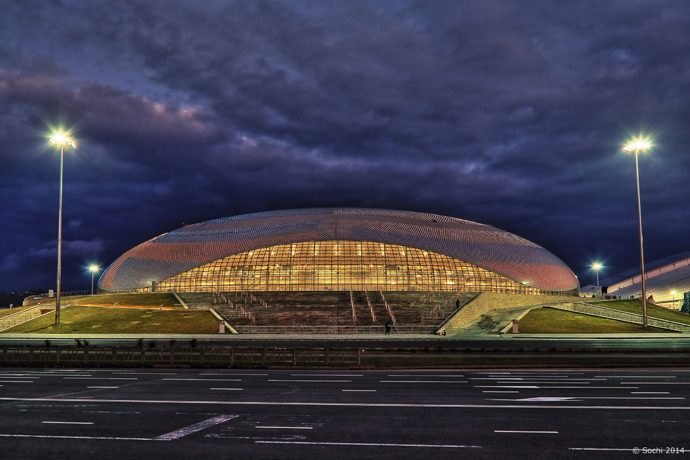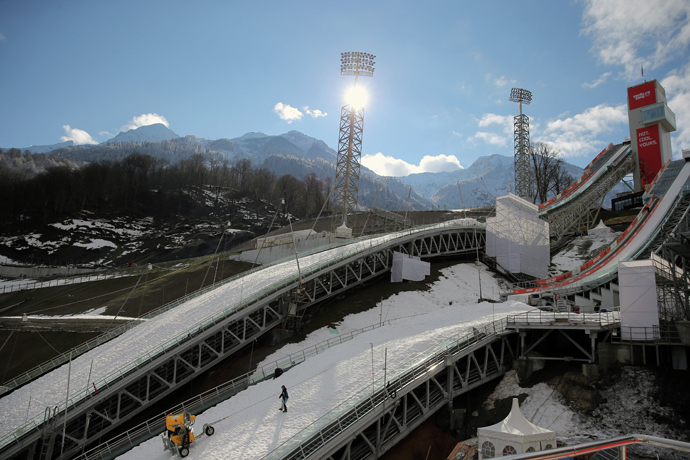Sochi Olympic town shown to media
7 02 2014
Sochi is rebuilt from a bustling but creaky and provincial resort to a world-class tourism capital.
Some locals have objected to seeing their hometown turned into a building site, and other Russians have balked at the bill for the Games, which totaled over $6 billion spent on the Olympic facilities and almost $40 billion spent on the development of the Krasnodar region, where the games took place.
Three hundred and sixty-three pieces of infrastructure have been constructed especially for the Olympics. Sochi has already provided the first spectacle with a record-breaking 65,000km Olympic torch relay that provided real insight into Russia. It has been hosted by 135 cities located in all of Russia’s 83 regions and republics. The longest nonstop leg of the relay spanned 2,055km, between the cities of Norilsk and Yakutsk in the Russian Far East.
Sochi Games will take place on two separate sites.
Down by the palm tree-dotted coast is the main cluster of indoor facilities and the Olympic village itself. Temperatures here rarely fall below freezing, and indeed Sochi is the warmest city to ever host the Winter Games.
The centerpiece is the 40,000 capacity Fisht Stadium – named after a local mountain – which will host the opening and closing ceremonies. Designed by Populous architectural firm, which rebuilt the stadium that hosted the last World Cup Final in Johannesburg, Fisht stadium will be expanded to host matches during the 2018 World Cup.

The Bolshoi Ice Dome along with the Shayba Arena will host ice hockey events.
The outdoor facilities are at Krasnaya Polyana, located 48km from the Coastal Cluster about 500 meters above sea level. At the moment, there is snow at the facilities – but just in case, there are 500 snow cannons on standby, ready to release 25 million cubic feet of snow saved up from previous winters.

Sanki’s statistics are impressive: 17 turns for men and 16 for women and pairs. The bobs will flash past with a maximum speed of around 135km per hour. The highest point is located at 836 meters above sea level and its lowest point at 704 meters.
Journalists are given a look inside living quarters for athletes and sports officials attending the Winter Olympics in Sochi. Media toured a 72-hectare compound on the Black Sea coast — one of 3 Olympic villages built for the Games. The facilities include a fitness club for the roughly 2,000 people expected to stay there.A cafeteria serving a variety of cuisines is open 24 hours a day.
Olympic torch arrived in Sochi on Wednesday, two days before the opening of the 2014 Winter Olympic Games in the Russian city.
A train carrying the Olympic flame reached Adler Station near Olympic Park, the main complex for skating events on the Black Sea coast, at noon on Wednesday.
A lantern holding the flame was taken to the public square in front of the station, where its arrival was celebrated with folk dancing and other events. It was later moved about 1 kilometer to a main road, where the Olympic torch was lit.
A cheer rose from people lining the road when a relayer holding the torch high in his right hand started to run.
About 300 runners will relay the torch for 3 days through the city center and mountain areas before bringing it to Fisht Olympic Stadium on Friday night for the opening ceremony.
The flame was delivered to Russia from Athens, Greece in October. Over the course of 4 months, it has been relayed around 65,000 kilometers from the capital Moscow to Sochi.
Olympic medals to be awarded to winning athletes have been put on display in Sochi ahead of the games.
They feature a traditional Russian mosaic pattern on a Sochi landscape, with snowy mountain tops reflecting the sun onto the sandy beaches of the Black Sea.
The medals are 10 centimeters in diameter, one centimeter thick, and made from metals produced in Russia. Transparent synthetic resin is used to portray ice.
A jewelry manufacturer was commissioned to make the medals. Artisans hand polished them so they would better reflect the light.
They’ve made a record 1,300 medals for the Sochi winter Olympics and Paralympics. The number of events has increased. Media agencies

No comments:
Post a Comment